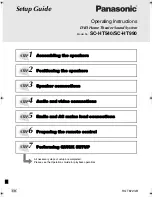
41
40
Project Everest loudspeaker connector panels have two sets
of terminals that provide a choice of three different connection
methods: single-wire, bi-wire and bi-amp. Use the most suitable
method for your audio system.
singLe-wire connecTion meThod
The single-wire method requires one amplifier channel and one
set of wires for each loudspeaker. You can make the connections
to either the loudspeaker’s upper set of terminals or its lower set of
terminals.
imPortant: do not remove the shortinG
STRAPS.
Make sure the conductors and sleeves of the shorting
straps are firmly fastened at the terminals.
Speaker wires may be fastened to the loudspeaker terminals by
several methods. The most positive connection is usually made
by directly connecting clean, bare wire (exposed by stripping the
insulation from the ends of the wire) to the terminal posts.
For this type of connection, loosen the knobs on the terminals to
expose the holes in the terminal shafts and insert the bare end
of each speaker wire into the hole exposed on the terminal shaft.
(Again, make sure to connect amplifier “+” to speaker “+” and
amplifier “–” to speaker “–”.) Tighten the knob on each terminal so
that a snug positive connection is achieved. Do not apply excessive
force and do not overtighten. To avoid a short circuit that could
damage the loudspeakers or your amplifier(s), trim off any excess
wire that is not in contact with the binding post contact surfaces.
a
B
c
d
Bare Wire Connection
Project Everest loudspeaker terminals are also designed to accept
spade connectors or banana connectors, which are fastened to the
ends of the wires and, in turn, are attached to the terminal posts.
a
B
c
d
Spade Connection
a
B
c
Banana Connection
Single-Wire Connection Method
Note: Do Not Remove Shorting Straps
Receiver or Amplifier
(one channel shown)
speaker
Connector Panel
use either set
of
terminals
Do not
remove
shorting straps






































